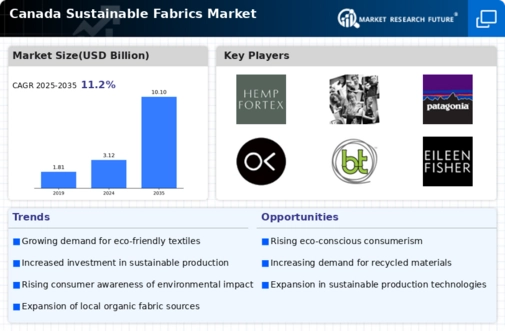The Canada Sustainable Fabrics Market is rapidly evolving, driven by increasing consumer awareness regarding environmental impacts and a collective push towards sustainable practices in the textile industry. The competitive landscape in this market is characterized by a growing number of players committed to eco-friendly materials, innovative manufacturing techniques, and ethical practices. Companies in Canada are not only focusing on sustainable sourcing but are also collaborating to drive positive change within the supply chain. The demand for sustainable fabrics is heightened by both consumer trends favoring environmentally responsible products and regulatory measures aimed at reducing the textile industry's carbon footprint.
This scenario fosters a competitive environment where innovation, transparency, and sustainability become the key differentiators for companies operating in the market.The Sustainable Apparel Coalition plays a crucial role in the Canada Sustainable Fabrics Market by advocating for sustainable practices within the apparel and textile industry. Their strength lies in their collaborative approach, bringing together various stakeholders, including brands, manufacturers, and NGOs, to develop shared goals and actions that reduce environmental impacts. The Coalition's transparency initiatives allow for better consumer understanding and trust, which is essential in this competitive landscape.
By promoting industry-wide standards for sustainability metrics, the Sustainable Apparel Coalition helps businesses streamline their sustainability efforts, ultimately benefiting the entire fabric supply chain within Canada.
The organization's focus on continuous improvement and regulatory compliance positions it as a significant entity in driving change and accountability in sustainable fabric production.Hemp Fortex is another key player in the Canadian sustainable Fabrics Market, specializing in sustainable textiles made primarily from hemp and other eco-friendly materials. The company is noted for its innovative product range that includes not only fabrics but also finished apparel and accessories, reflecting a comprehensive approach to sustainability.
With a robust market presence, Hemp Fortex has established itself as a go-to source for brands looking for sustainable fabric solutions in Canada. The company's strengths lie in its commitment to quality and environmental responsibility, and its ongoing partnerships foster development. Additionally, Hemp Fortex has engaged in various strategic alliances and collaborations to enhance its product offerings and expand its market reach. These efforts underscore the company’s dedication to creating a strong supply chain that prioritizes sustainability, making it a notable competitor in the rapidly evolving sustainable fabrics market in Canada.




















